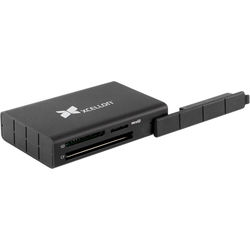All In One Mini Card Reader Drivers For Mac
Marmoset Toolbag 3. September 27, 2016. License Type. – Platform-independent (Mac & PC), perpetual licensing – Free point release updates – Free email support. Marmoset tool bag tutorial. Marmoset Toolbag 3.03 Size: 330.28 MB. Team Marmoset LLC. Has released an updated (version 3.03) Marmoset Toolbag 3. The latest version brings Mac support, Python scripting, and a host of other features and bug fixes. Team Marmoset LLC. Has released an updated (version 3.03) Marmoset Toolbag 3. The latest version brings Mac support, Python scripting, and a host of other features and bug fixes.
Mac notebooks use the USB bus to communicate with the SD card slot. They have a maximum speed of up to 480Mbit/s.
Mac desktops use the PCIe bus to communicate with the SD card slot. Office 2016 office 2016 for mac 2016 review. Desktops can transfer data at a faster rate. Check the packaging that came with your SD media to determine the maximum transfer rate that your specific card uses. To determine the maximum transfer speed of your Mac, you can use System Information.
Re: USB Card Reader Not Recognised In reply to Michael Kilpatrick • Apr 28, 2007 I think installing another OS for such a simple task is a little bit of an overreaction to what 99.9% of Mac users would feel is a non-problem. Original Title: esecure all in 1 mini card reader. Have installed the above device on my laptop with a CF card in the device. I'm unable to view or upload the images that are on the card.
Choose Apple () menu >Droid explorer for mac. About This Mac and then click System Report. If you use a Mac notebook: • Select Hardware, then select USB.
• Select Internal Memory Card Reader and look for the Speed entry. If you use a Mac desktop computer: • Select Hardware, then select Card Reader.
• Look for the Link Speed entry. Computers that use the PCIe bus express their speed as GT/s. However, most media manufacturers preformat the media using common block-and-cluster sizes that don’t approach the theoretical limits of a given file system. Most SD cards use the FAT32 file format, and preformatted FAT32 SD media is commonly available up to a capacity of 32GB. Media that exceeds 32GB usually uses the exFAT file system, while some smaller capacity cards use the FAT16 file format. Preformatted FAT16 media is generally available up to a capacity of 2GB.
If you use OS X Snow Leopard 10.6.5 or later, you can find out which file system you’re using: • Insert the media into the SD card slot. • Choose Apple menu > About This Mac. • Click System Report. • In the Hardware section, click Card Reader, and find the File System field. Information about products not manufactured by Apple, or independent websites not controlled or tested by Apple, is provided without recommendation or endorsement. Apple assumes no responsibility with regard to the selection, performance, or use of third-party websites or products. Apple makes no representations regarding third-party website accuracy or reliability.
Risks are inherent in the use of the Internet. For additional information. Other company and product names may be trademarks of their respective owners.
Mac notebooks use the USB bus to communicate with the SD card slot. They have a maximum speed of up to 480Mbit/s. Mac desktops use the PCIe bus to communicate with the SD card slot. Desktops can transfer data at a faster rate. Check the packaging that came with your SD media to determine the maximum transfer rate that your specific card uses. To determine the maximum transfer speed of your Mac, you can use System Information. Choose Apple () menu > About This Mac and then click System Report.
All In 1 Mini Card Reader Driver Mac

If you use a Mac notebook: • Select Hardware, then select USB. • Select Internal Memory Card Reader and look for the Speed entry.
If you use a Mac desktop computer: • Select Hardware, then select Card Reader. • Look for the Link Speed entry. Computers that use the PCIe bus express their speed as GT/s. However, most media manufacturers preformat the media using common block-and-cluster sizes that don’t approach the theoretical limits of a given file system. Most SD cards use the FAT32 file format, and preformatted FAT32 SD media is commonly available up to a capacity of 32GB. Media that exceeds 32GB usually uses the exFAT file system, while some smaller capacity cards use the FAT16 file format. Preformatted FAT16 media is generally available up to a capacity of 2GB.
Mini Credit Card Reader
If you use OS X Snow Leopard 10.6.5 or later, you can find out which file system you’re using: • Insert the media into the SD card slot. • Choose Apple menu > About This Mac. • Click System Report. • In the Hardware section, click Card Reader, and find the File System field.
Information about products not manufactured by Apple, or independent websites not controlled or tested by Apple, is provided without recommendation or endorsement. Apple assumes no responsibility with regard to the selection, performance, or use of third-party websites or products. Apple makes no representations regarding third-party website accuracy or reliability. Risks are inherent in the use of the Internet. For additional information.